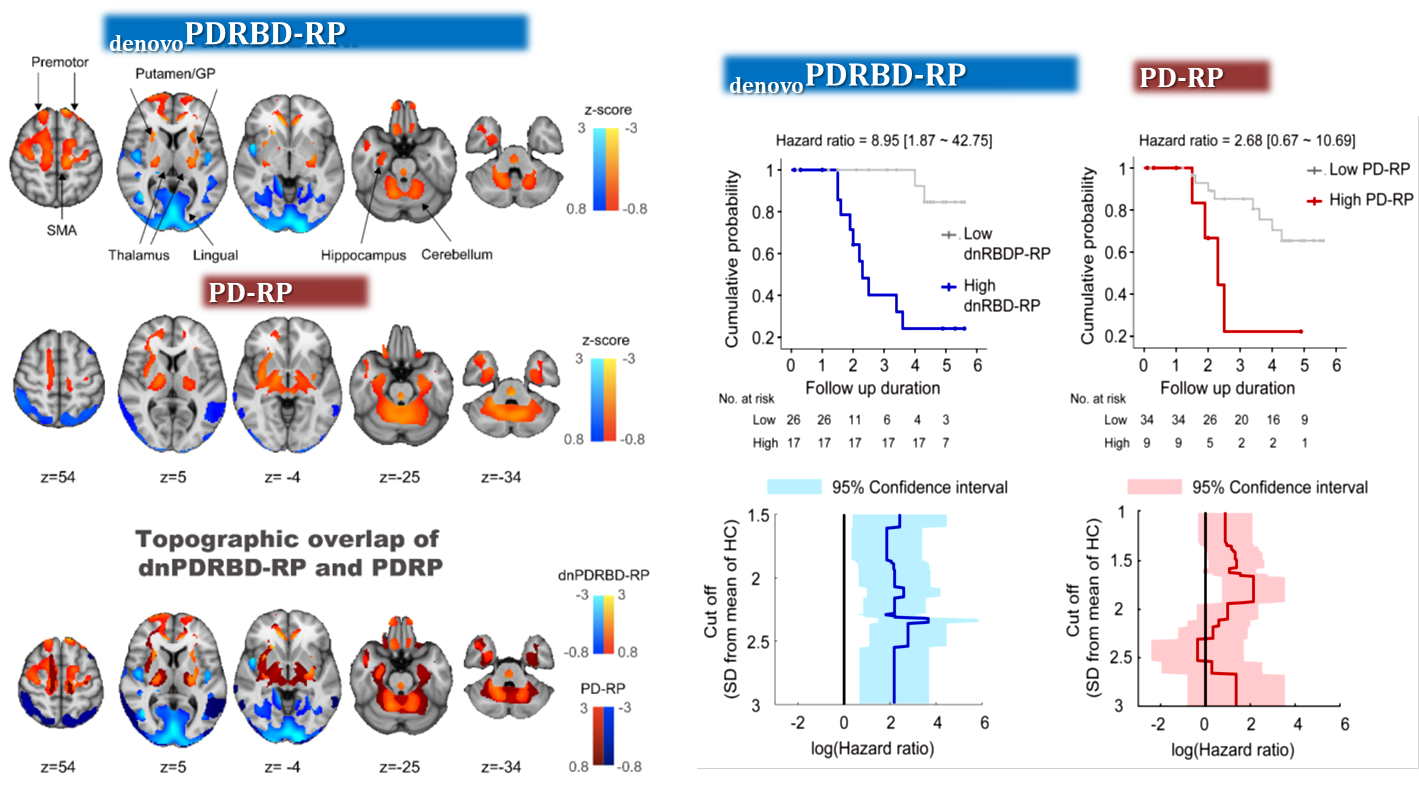글로벌 연구동향
핵의학
- [Neurology.] Parkinson Disease-Related Brain Metabolic Patterns and Neurodegeneration in Isolated REM Sleep Behavior Disorder
서울의대, 서울특별시보라매병원 / 신정환, 이지영*, 김유경*
- 출처
- Neurology.
- 등재일
- 2021 May 19
- 저널이슈번호
- 10.1212/WNL.0000000000012228. doi: 10.1212/WNL.0000000000012228.
- 내용
Abstract
Objective: To elucidate the role of Parkinson's disease (PD)-related brain metabolic patterns as a biomarker in isolated rapid-eye-movement sleep behavior disorder (iRBD) for future disease conversion.Method: This is a prospective cohort study consisting of 30 iRBD patients, 25 de novo PD patients with a premorbid history of RBD, 21 long-standing PD patients on stable treatment and 24 healthy controls. iRBD group was longitudinally followed up. All participants underwent 18F-Fluorodeoxyglucose (FDG) PET and were evaluated with olfaction, cognition, and the Movement disorders society-Unified PD Rating Scale (MDS-UPDRS) at baseline. From FDG-PET scans, we derived metabolic patterns from the long-standing PD group (PD-RP) and de novo PD group with RBD (dnPDRBD-RP). Subsequently, we calculated the PD-RP and dnPDRBD-RP scores in iRBD patients. We validated the metabolic patterns in each PD group and separate iRBD cohort (n=14).
Result: The two patterns significantly correlated with each other and were spatially overlapping yet distinct. The MDS-UPDRS motor scores significantly correlated with PD-RP (p = 0.013) but not with dnPDRBD-RP (p = 0.076). In contrast, dnPDRBD-RP correlated with olfaction in butanol threshold test (p = 0.018) in iRBD subjects, but PD-RP did not (p = 0.21). High dnPDRBD-RP in iRBD patients predicted future phenoconversion with all cut-off ranges from 1.5 to 3 standard deviations of the control value, whereas predictability of PD-RP was only significant in a partial range of cut-off.
Conclusion: The dnPDRBD-RP is an efficient neuroimaging biomarker that reflects prodromal features of PD and predicts phenoconversion in iRBD that can be applied individually.

Affiliations
Jung Hwan Shin 1 , Jee-Young Lee 2 , Yu-Kyeong Kim 3 , Eun Jin Yoon 4 , Heejung Kim, Hyunwoo Nam 1 , Beomseok Jeon 5
1 Department of Neurology, Seoul Metropolitan Government-Seoul National University Boramae Medical Center & Seoul National University College of Medicine, Seoul, South Korea.
2 Department of Neurology, Seoul Metropolitan Government-Seoul National University Boramae Medical Center & Seoul National University College of Medicine, Seoul, South Korea wieber04@snu.ac.kr yk3181@snu.ac.kr.
3 Department of Nuclear medicine, Seoul Metropolitan Government-Seoul National University Boramae Medical Center, Seoul, South Korea wieber04@snu.ac.kr yk3181@snu.ac.kr.
4 Department of Nuclear medicine, Seoul Metropolitan Government-Seoul National University Boramae Medical Center, Seoul, South Korea.
5 Department of Neurology, Seoul National University Hospital & Seoul National University College of Medicine, Seoul, South Korea.
- 연구소개
- 본 연구진은 F-18-fluorodeoxyglucose (FDG) PET 영상을 이용하여 Scaled Subprofile Model, Principal Component Analysis (SSM-PCA)에 기초하여 파킨슨병을 설명할 수 있는 공간 공분산 패턴(spatial covariance pattern)을 만들었습니다. 뇌 FDG PET에서 기존 알려진 파킨슨병 연관 패턴(PD related pattern, PD-RP)외에, 보라매병원 코호트인 전구 파킨슨병단계 렘수면행동장애(RBD)에서 병리가 진행하여 처음 파킨슨병이 발병한 환자들의 치료시작 시점에서의 뇌 FDG PET 영상으로 denovoPDRBD 연관 패턴 (denovoPDRBD-RP)을 별도로 만들었습니다. 이 두 개의 파킨슨병 연관 패턴을 RBD 환자 코호트에 적용하여 약 5년간 전향적으로 관찰한 자료를 분석하였습니다. 본 논문은 최초의 전향적 분석을 통해 뇌대사능 공간 공분산 패턴이 파킨슨병 전구단계에서 진행을 예측하는 뇌영상바이오마커가 된다는 사실을 증명하였다는 점에서 의의가 있습니다. 특히 denovoPDRBD 연관 패턴(Hazard Ration, HR=8.9)이 기존 PD 연관 패턴(HR=2.7)에 비해 진행위험도 예측력이 월등하였으며, 이는 본 연구진이 이전에 발표한 도파민운반체 영상의 예측력(HR=4.5)보다도 더 우세하여 FDG PET 영상의 임상적 유용성을 입증한 연구입니다.
- 덧글달기
- 이전글 [Eur Heart J.] Stress-associated neurobiological activity is linked with acute plaque instability via enhanced macrophage activity: a prospective serial 18F-FDG-PET/CT imaging assessment
- 다음글 [J Nucl Med.] 89 Zr-Labeled Anti-PD-L1 Antibody PET Monitors Gemcitabine Therapy-Induced Modulation of Tumor PD-L1 Expression









